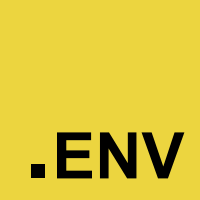Dotenv nodejs что это
Raddy The Brand Official Website
How to use environment variables with Node.js – dotenv tutorial
By Raddy in NodeJs · 13th July 2021
Environment variables are variables external to our application that resides in the OS or the container of the app is running in. Typically, our applications require many variables. By separating our configurations, our application can easily be deployed in a different environment and we won’t have to change the application code and then having to rebuild it.
By convention, the variables are capitalised example: “DB_NAME” and the values are strings. Simply put, an environment variable is simply a name mapped to a value – “NAME=VALUE”. For example:
Creating Hello World App
Let’s explore how we can put dotenv into practice. First, let’s start by creating a new “Hello World” application.
Let’s start by creating a new Node.JS Project. To do that, create a new project folder and then run the following command in Command Line (Mac / Linux) or Powershell (Windows).
This will initialise a new project for you and it’s going to ask you a few questions about your project. The most important one is to give your package a name and then you can just keep pressing enter until the installation is over.
You can skip all questions by adding the “-y” flag like in the example below:
At this point, you should see a file called package.json in your project folder.
Dependencies Installation
The only dependency that we need for this project is dotenv. This time we will start the server manually as we won’t be making too many changes to the code.
Open the Command Line / Terminal / Powershell and install dotenv:
Your packages.json file should look similar to this:
Note that the version of the dependencies might change in the future.
Project Structure
Our project is going to be simple. We just want to see how we can use dotenv. All we need to do is to create an “app.js” and the “.env” file.
Usage
We need to require dotenv as early as possible in our application in order to be able to access the environment variables that we will create shortly.
In “app.js” file require dotenv by adding the following line of code:
Another thing that you can do is to change the default “utf8” encoding:
In the example above “MESSAGE” is our variable name and “HELLO WORLD” is our string – value. Let’s display the value in our “app.js” file by console logging it.
Back to our “app.js” file we can bring the environment variable by using “process.env” and then the variable name:
To run this, open your console and run “app.js” with node by doing the following:
This should run our application and console log the message and that’s pretty much it! Fairly simple, yet super useful.
Remember not to upload your keys, passwords and so on in places like Github. Use gitignore to prevent that from happening.
Real Life Example – Simple HTTP Server
Let’s say that we wanted to create a very simple HTTP Server using Node.js. You could use the “.env” file to store the hostname and the port name like in the example below:
In the example below, we will pull the “HOSTNAME” and the PORT:
Now run the application:
If everything went well, you should get a message in your console saying “Server running at http://127.0.0.1:3000”. This means that you successfully pulled out the environment variables and created a very simple HTTP Server.
If you open the address in your browser “http://127.0.0.1:3000” you should get “Hello World”.
This was a very simple example of how you might use dotenv. I hope that you enjoyed this simple article. Thank you for your time and if you have any questions please comment below.
Tips are never expected, but deeply appreciated if you are able. It helps me create more content like this.
Thank you for reading this article. Please consider subscribing to my YouTube Channel.
Dotenv nodejs что это



As early as possible in your application, require and configure dotenv.
The configuration options below are supported as command line arguments in the format dotenv_config_ =value
Additionally, you can use environment variables to set configuration options. Command line arguments will precede these.
Default: path.resolve(process.cwd(), ‘.env’)
You may specify a custom path if your file containing environment variables is located elsewhere.
You may specify the encoding of your file containing environment variables.
You may turn on logging to help debug why certain keys or values are not being set as you expect.
The engine which parses the contents of your file containing environment variables is available to use. It accepts a String or Buffer and will return an Object with the parsed keys and values.
You may turn on logging to help debug why certain keys or values are not being set as you expect.
The parsing engine currently supports the following rules:
In a twelve-factor app, env vars are granular controls, each fully orthogonal to other env vars. They are never grouped together as “environments”, but instead are independently managed for each deploy. This is a model that scales up smoothly as the app naturally expands into more deploys over its lifetime.
What happens to environment variables that were already set?
If you want to override process.env you can do something like this:
Can I customize/write plugins for dotenv?
What about variable expansion?
When you run a module containing an import declaration, the modules it imports are loaded first, then each module body is executed in a depth-first traversal of the dependency graph, avoiding cycles by skipping anything already executed.
NODE ENV в Node JS или что такое переменные окружения
В этой статье поговорим о переменных окружения, для чего они нужны, что такое NODE ENV (NODE_ENV), как установить переменную окружения и как это поможет настроить конфигурацию webpack.
Переменные окружения это специальные переменные, которые определяются самой операционной системой. Эти переменные используются программами во время их выполнения. Такие переменные может задавать как сама система, так и пользователь. Самой известной переменой является PATH. Чтобы найти нужные файлы в окне терминала ОС использует значение этой переменной.
Существует три вида переменной окружения:
Локальные переменные окружения
Такие переменные существуют только для текущей сессии. После завершения сессии они будут удалены. Локальные переменные не хранятся ни в каких файлах, а создаются и удаляются с помощью команд в терминале.
Пользовательские переменные окружения
Пользовательские переменные окружения задаются для каждого пользователя и загружаются когда пользователь входит в систему при помощи локального терминала или удаленно. Обычно, такие переменные хранятся в файлах конфигурации, которые хранятся в директории пользователя.
Системные переменные окружения
Это глобальные переменные, которые доступны во всей системе, для любого пользователя. Такие переменные хранятся в системных файлах конфигурации и запускаются при старте системы.
NODE ENV
Свойство env объекта process и поможет нам повлиять на сборку webpack. Например, нам нужно динамически менять mode в конфигурации webpack. Для этого определим переменную ENV в webpack.config.js.
Теперь нам нужно задать переменную окружения NODE_ENV. Проблема в том, что в различных операционных системах переменные окружения задаются по разному. В Windows переменные окружения задаются командой SET, в Linux используется команда export, а в Mac OS команда env. Эту проблему поможет решить пакет cross-env. Он поможет определить временную переменную окружения в одном виде для всех ОС. Для этого установим пакет cross-env из npm. В файле package.json определим следующие скрипты для npm.
Таким образом, если мы запустим команду npm run dev, то в переменную ENV придёт строка «development» и у нас соберётся dev сборка. Аналогично с командой npm run prod.
Переменные окружения в отдельном файле
Заключение
Теперь вы знаете что такое NODE ENV, что как такое переменные окружения и как с их помощью управлять сборкой webpack. Надеюсь, эта статья была вам полезной.
Президент США Джо Байден ужесточает ограничения в отношении Huawei и ZTE
Samsung заявляет, что Android 12 и One UI 4 готовы для Galaxy S21
Опрос в Twitter призывает Элона Маска продать 10% акций Tesla
800 000 человек играют в Forza Horizon 5, а она еще даже не вышла
Исследователи Массачусетского технологического института создали ИИ, который может сделать роботов лучше
Instagram @web.dev.setups
Так называемый принцип Парето был сформулирован в 19 веке. Он говорит, что 20% усилий принесут 80% результата, и наоборот, 80% усилий принесут только 20% результата. Этот закон Парето можно применить в любой сфере жизни. Взглянем на примеры: 20% книг дают 80% знаний, 20% злоумышленников совершают 80% преступлений, 20% всех людей на планете владеют 80% всех денег в мире.
Проанализируйте, какие именно действия принесут вам большую отдачу и отдайте предпочтение именно им. Сконцентрируйтесь на 20% вещах, которые обеспечат вам максимальную отдачу.
⚡Нездоровый перфекционизм это зло
Самокритика хороша только до того момента когда вы перестаете здраво оценивать свои возможности, и стараетесь перейти поставленную планку. В такой момент лучше отставить в сторону черезмерные претензии к самому себе – наша жизнь сама по себе неидеальна. Перестаньте копаться в мелких деталях – этим вы себе только навредите, особенно учитывая тот факт, что копаться в себе можно до бесконечности.
⚡Разрешайте себе отдыхать
⚡Сложно сохранить ровную осанку когда ты сидишь за столом 4, 6 или 8 часов. Спина постоянно ищет удобное положение и интуитивно мы начинаем сползать с кресел вниз. Чтобы этого не произошло нужно использовать подставку для ног.
⚡Подставка для ног позволяет телу испытывать минимальные напряжения и позволяет спине полностью откинуться на стул. Таким образом заняв правильное положение на рабочем месте, можно избавиться от усталости мышц спины и затекания ног.
Dotenv nodejs что это






As early as possible in your application, require and configure dotenv.
The configuration options below are supported as command line arguments in the format dotenv_config_ =value
Additionally, you can use environment variables to set configuration options. Command line arguments will precede these.
Default: path.resolve(process.cwd(), ‘.env’)
You may specify a custom path if your file containing environment variables is located elsewhere.
You may specify the encoding of your file containing environment variables.
You may turn on logging to help debug why certain keys or values are not being set as you expect.
The engine which parses the contents of your file containing environment variables is available to use. It accepts a String or Buffer and will return an Object with the parsed keys and values.
You may turn on logging to help debug why certain keys or values are not being set as you expect.
The parsing engine currently supports the following rules:
In a twelve-factor app, env vars are granular controls, each fully orthogonal to other env vars. They are never grouped together as “environments”, but instead are independently managed for each deploy. This is a model that scales up smoothly as the app naturally expands into more deploys over its lifetime.
What happens to environment variables that were already set?
If you want to override process.env you can do something like this:
Can I customize/write plugins for dotenv?
What about variable expansion?
When you run a module containing an import declaration, the modules it imports are loaded first, then each module body is executed in a depth-first traversal of the dependency graph, avoiding cycles by skipping anything already executed.
dotenv





Install
Usage
As early as possible in your application, require and configure dotenv.
Preload
The configuration options below are supported as command line arguments in the format dotenv_config_ =value
Additionally, you can use environment variables to set configuration options. Command line arguments will precede these.
Config
Options
Default: path.resolve(process.cwd(), ‘.env’)
You may specify a custom path if your file containing environment variables is located elsewhere.
Encoding
You may specify the encoding of your file containing environment variables.
Debug
You may turn on logging to help debug why certain keys or values are not being set as you expect.
Parse
The engine which parses the contents of your file containing environment variables is available to use. It accepts a String or Buffer and will return an Object with the parsed keys and values.
Options
Debug
You may turn on logging to help debug why certain keys or values are not being set as you expect.
Rules
The parsing engine currently supports the following rules:
In a twelve-factor app, env vars are granular controls, each fully orthogonal to other env vars. They are never grouped together as “environments”, but instead are independently managed for each deploy. This is a model that scales up smoothly as the app naturally expands into more deploys over its lifetime.
What happens to environment variables that were already set?
If you want to override process.env you can do something like this:
Can I customize/write plugins for dotenv?
What about variable expansion?
When you run a module containing an import declaration, the modules it imports are loaded first, then each module body is executed in a depth-first traversal of the dependency graph, avoiding cycles by skipping anything already executed.
You must run dotenv.config() before referencing any environment variables. Here’s an example of problematic code:
client will not be configured correctly because it was constructed before dotenv.config() was executed. There are (at least) 3 ways to make this work.
Contributing Guide
Change Log
Who’s using dotenv?
Projects that expand it often use the keyword «dotenv» on npm.







